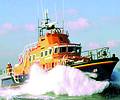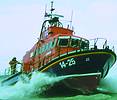GTX helps rescue RNLI from drowning in a sea of paper
July 2001

The Royal National Lifeboat Institution (RNLI) is a charity that exists to save lives at sea. It provides, on call, 24 h service necessary to cover search and rescue requirements up to 50 miles (80 km) out from the coast of the United Kingdom and the Republic of Ireland
Founded originally in 1824, the RNLI now saves on average more than 1000 lives a year, as a result of more than 6000 launchings from a fleet of more than 300 lifeboats.
It is not surprising that the modern RNLI uses the latest in computer hardware and software to help them achieve and maintain their impressive record. Computers pervade all aspects of the RNLI today, but no more so than in the design and maintenance of the lifeboats.
New lifeboats are designed in the RNLI engineering office and pose some unique problems. The boats must be small enough to get close to casualties, strong enough to go to sea in the worst weather, well equipped with navigation, communications and survival gear, stable enough to make capsize unlikely and self-righting in case they should be capsized! Like all boats, their design has to be a compromise.
To help in these design and maintenance tasks the RNLI has installed a number of AutoCAD and GTXRaster CAD seats at their Poole, Dorset, UK Headquarters. Replacing an older Unix-based system, the RNLI has worked closely with Adris, the Southampton-based computer applications and CAD specialist supplier, to specify and install a comprehensive hardware and software system which looks after all aspects of its design and maintenance work.
Most of the all-weather boats have an operational life of 20 years. It is perhaps not surprising that during this lifetime a large amount of paper drawings (approximately 40 000) have accumulated. This reflects the individual changes and modifications that occur to each 'class', including the latest classes of lifeboat, the 'Trent' and 'Severn', both introduced in 1993.
These drawings are being scanned onto the RNLI system using a Calcomp wide-format scanner, and when combined with the TIFF files generated by the previous (CDDS5/Formtek) system provide the bulk of the raster files that the RNLI has to keep updated.

The RNLI has found that using the comprehensive raster editing facilities of the GTXRaster CAD product it is not normally necessary for them to convert their raster drawing files into vector. They are able to maintain and update their scanned drawings very efficiently in raster using the unique Intelligent Object Picking (IOP) capabilities of GTXRaster CAD, which enables them to handle raster entities as if they were vector/CAD entities.
RNLI's current configuration consists of a network of 10 AutoCAD seats, nine of which are running GTXRaster CAD, mainly used for intelligent raster editing work, as well as one seat of GTXRaster CAD PLUS, for when automatic raster-to-vector conversion is required.
As David Wilson, RNLI's CAD Manager, commented, "GTXRaster CAD provides a very comprehensive and user-friendly environment for RNLI to maintain, edit and update our electronic drawing files, whether they have been scanned in or are part of our electronic legacy archive from the previous system." He added, "When compared with our previous manual methods of update, using GTXRaster CAD has made it possible for us to keep our drawings up to date and correct in a much more efficient and cost-effective way."
As with many organisations, especially those with a running cost of more than £88 million (R968 million) per year, the RNLI is constantly seeking to upgrade its computer systems to take advantage of the latest technology and achieve even more cost savings and efficiency. RNLI has implemented SAP, and with the help of Adris's expertise to develop an interface between SAP and their design and drawing maintenance systems, the GTX software will continue to provide essential tools for the maintenance of the RNLI electronic drawing archive.
The RNLI is justifiably proud of the fact that its lifeboats are manned by highly trained volunteer crews, and every penny required to maintain the lifeboat service is raised from voluntary contributions and legacies. Its determination to provide a modern, world leading marine rescue service is as great now as it was 176 years ago when it was founded. The 134 000 lives saved in that period are an appropriate testament to the success of their service.
GTX is represented locally by Imaging Innovations, tel: (011) 285 0075, www.imaginginnovations.co.za
Others who read this also read these articles
EDM - who needs it?
An EDMS is basically a computer database system designed for keeping track of documents, changes to them, related documents, and possibly to control the access to documents and assist or even enforce established procedures for workflow or QA[ December 2005 ]
Spatial document management
ProjectWise is the most popular technical document and AEC content management tool in SA and adding a spatial component opens up a whole new dimension[ August 2004 ]
What is up, docs?
DvTDM, the Total Document Manager developed by Practical Programs, and is available from Kinetic Distribution, can actually be configured to force documents to be stored within the system[ August 2004 ]
The CAD File is the business
CAD files form the technical foundation from which industrial businesses and plants are run[ August 2003 ]
The high cost of information erosion
Intergraph Process, Power & Offshore has developed integrated solutions and products to assure data accuracy and consistency, and enable the efficient creation, management and use of plant engineering information throughout the plant lifecycle[ June 2003 ]
Powerful document management solution
DataViewer X is an advanced Document and Drawing Management solution that can interface with leading CAD products to produce advanced technical and product document solutions[ February 2003 ]
Digital signatures resolve electronic catch-22
The much-touted 'paperless' work environment has finally become a reality[ December 2002 ]
MicroStation V8 is e-ready for digital signatures
Recent acknowledgment of digital IDs, certificates, and signatures offers new opportunities to streamline workflows and strengthen the protection of one's digital intellectual property[ October 2002 ]
Others who read this also read these news items
A solution to CAD data management problems
[ October 2005 ]
Engineer your drawing management
[ August 2005 ]
The paperless age
[ June 2005 ]
Effectively handle document processes
[ April 2004 ]
Flexible solution for digitising drawings
[ February 2004 ]
Dataviewer X gets new name and enhancements
[ February 2004 ]
World's largest export coal terminal discovers SAP DMS
[ February 2004 ]
New software to index and archive scanned drawings
[ February 2004 ]
Others who read this also read these regulars
Search Site
Subscribe
Previous Issues
Other Technews Publications
Other Technews Buyers Guides
 |  | Copyright c1995-2009 Technews Publishing (Pty) Ltd.. All rights reserved. |